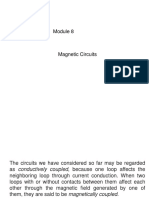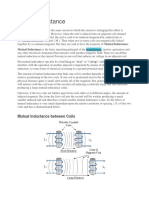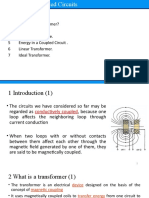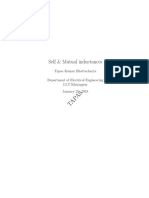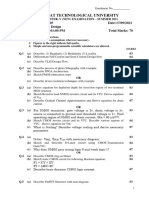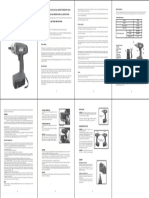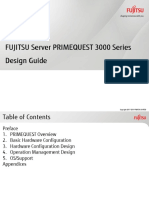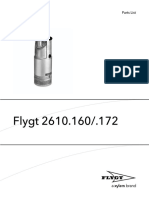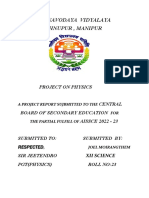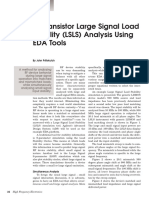Coupled Circuits
Introduction
➢ Circuits connected by physical wires and parameter variation in one of the
circuit/loop affecting other circuit/loop– Conductively coupled circuits.
➢ Some circuits does not require physical wires to have an impact on the
neighboring circuit – Magnetically coupled circuits
➢ When two circuits are brought in close proximity that when a change occurs
in a circuit affects the neighboring circuit by magnetic coupling they are
said to be Inductively coupled circuits
➢ Transformers and induction motors are examples of inductive coupled
circuits (or) principle of mutual induction.
�Types of induced EMFs
� Self Inductance
➢ When a current i flows in a coil of N number of turns, it produces a magnetic flux φ around it.
➢ By Faraday’s law, the voltage V induced in the coil is proportional to the number of turns N and the
rate of change of the magnetic flux φ with respect to the time
𝑑𝜑
𝑣=𝑁
𝑑𝑡
Current i should change if it is required to have change in flux φ, hence the above equation can be changed as
𝑣 = 𝑁 𝑑𝜑 𝑑𝑖
𝑑𝑖 𝑑𝑡
𝑑𝜑 This value of inductance is called a Self inductance of the
Comparing the two equations: 𝐿 = 𝑁
𝑑𝑖 coil in Henry
Self inductance relates the voltage induced in a coil by a time-varying current in the same coil.
� Mutual Inductance
➢ Word Mutual relates two.
➢ Consider two coils of turns N1 and N2 placed close to each other.
➢ Coil 1 is carrying current and it generates flux that will have two components
➢ One component φ11 links only coil 1, and another component φ12 links both coils
Although the two coils are physically separated, they are said to be magnetically
coupled.
𝑑𝜑1
𝑣𝑜𝑙𝑡𝑎𝑔𝑒 𝑖𝑛𝑑𝑢𝑐𝑒𝑑 𝑖𝑛 𝑐𝑜𝑖𝑙1 = 𝑉1 = 𝑁1
𝑑𝑡
M21 is called the mutual inductance of coil 2 with respect to coil 1 measure in Henry
The voltage induced in coil 2 is called Mutual voltage (or) Induced Voltage
�Conversely….
L2 is the self inductance of coil 2
M12 is called the mutual inductance of coil 1 with respect to coil 2 measure in Henry
M is the mutual inductance between the two coils
Mutual inductance is the ability of one inductor to induce a voltage across a neighboring
inductor, measured in henrys (H).
� Polarity of Mutual induced Voltage
Self induced voltage involves only two terminals where in the current direction and reference polarity
of voltage helps to easily obtain the polarity of the induced voltage.
Self induced voltage Mutual induced voltages
In Mutual Inductance, the mutually induced voltage polarity is difficult to determine as there
are two elements and four terminals involved.
Mutual induced voltage polarity depends on: 1. Orientation of turns in the two coils
2. Current entering / leaving the two coils
It can be found by physical interpretation of Lenz’s law and right hand rules knowing the above two.
DOT convention is used to reduce the confusion in dealing with polarity of mutual induced voltage
� DOT Convention
Dot convention : A dot is placed in the circuit at one end of each of the two magnetically coupled coils
to indicate the expected direction of the magnetic flux, if current enters that dotted terminal of the coil.
Understanding the Dot convention helps in knowing the polarity of Mutual induced voltage
�Polarity of Mutual induced voltage
Case 1 Case 2
�Polarity of Mutual induced voltage
Case 3 Case 4
�Polarity of Mutual induced voltage
Case 1 Case 3
Case 2 Case 4















